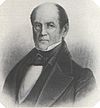Nebraska's 4th congressional district is an obsolete district. It was created after the 1890 census and abolished after the 1960 census.
Nebraska's 5th congressional district is an obsolete district. It was created after the 1890 United States census and eliminated after the 1940 United States census.
Kansas's 7th congressional district for the United States House of Representatives in the state of Kansas was a congressional district until its elimination in 1943.
Minnesota's 9th congressional district is a now-obsolete district for representation in the United States House of Representatives which existed from 1903 to 1963. It generally consisted of the northwest corner of the state.
Arkansas's 5th congressional district was a congressional district for the United States House of Representatives in Arkansas from 1885 to 1963.
Arkansas's 6th congressional district was a congressional district for the United States House of Representatives in Arkansas from 1893 to 1963.

Massachusetts's 18th congressional district is an obsolete district. During its short tenure of 1813–1821 it was located in the District of Maine, prior to Maine achieving statehood.
Maine's 3rd congressional district is an obsolete congressional district. It was created in 1821 after Maine achieved statehood in 1820 as part of the enactment of the Missouri Compromise. It was eliminated in 1963 after the 1960 U.S. census. Its last congressman was Clifford McIntire.
Maine's 5th congressional district was a congressional district in Maine. It was created in 1821 after Maine achieved statehood in 1820. It was eliminated in 1883. Its last congressman was Thompson Henry Murch.
The 12th congressional district of Missouri was a congressional district for the United States House of Representatives in Missouri from 1873 to 1953.
The 11th congressional district of Missouri was a congressional district for the United States House of Representatives in Missouri from 1873 to 1963.
The 22nd congressional district of Illinois was a congressional district for the United States House of Representatives in Illinois. It was eliminated as a result of the 1990 census. It was last represented by Glenn Poshard who was redistricted into the 19th district.
Virginia's 14th congressional district is an obsolete congressional district. It was eliminated in 1853 after the 1850 U.S. census. Its last congressman was James M. H. Beale.
Virginia's 16th congressional district is an obsolete congressional district. It was eliminated in 1843 after the 1840 U.S. census. Its last congressman was William A. Harris.
Virginia's 21st congressional district is an obsolete congressional district. It was eliminated in 1843 after the 1840 U.S. census. Its last congressman was Lewis Steenrod.
Pennsylvania's twentieth congressional district was a congressional district in southwestern Pennsylvania. It was created following the 1830 census and was disbanded after the 2000 census removed two representatives from Pennsylvania. The 18th district is generally considered to be its successor, although the 12th district contains some of its territory.
Indiana's 11th congressional district was a congressional district for the United States House of Representatives in Indiana. In its final configuration, it covered most of the southern portion of Indianapolis. It was eliminated as a result of the redistricting cycle after the 1980 census.
Indiana's 12th congressional district was a congressional district for the United States House of Representatives in Indiana. It was eliminated as a result of the 1940 census. It was last represented by Louis Ludlow who was redistricted into the 11th district.
Indiana's 13th congressional district was a congressional district for the United States House of Representatives in Indiana. It was eliminated as a result of the 1930 census. It was last represented by Samuel B. Pettengill who was redistricted into the 3rd district.
Pennsylvania's 23rd congressional district was one of Pennsylvania's districts of the United States House of Representatives.








